Sustainable Farming magazine V5 I2 -- Summer 2020
News: COVID-19: Fight Or Flight; Cattle: Stay In Control; Regenerative Standards Opinion: Britain At Breaking Point? Cover feature: COVID-19 Fight Or Flight Cover feature: New Standard (Certified Regenerative by AGW) Technical: A Brave New World Technical: In Control Of Our Impulses Technical: New Approaches To Worming Technical: The Immune System Technical: Chicken On Grass Certification News: Desktop Audits Meet the Farmer: Lazy A Ranch in Texas
News: COVID-19: Fight Or Flight; Cattle: Stay In Control; Regenerative Standards
Opinion: Britain At Breaking Point?
Cover feature: COVID-19 Fight Or Flight
Cover feature: New Standard (Certified Regenerative by AGW)
Technical: A Brave New World
Technical: In Control Of Our Impulses
Technical: New Approaches To Worming
Technical: The Immune System
Technical: Chicken On Grass
Certification News: Desktop Audits
Meet the Farmer: Lazy A Ranch in Texas
Create successful ePaper yourself
Turn your PDF publications into a flip-book with our unique Google optimized e-Paper software.
“Research shows
that Sericea lespedeza
can reduce the blood
sucking and egg laying
ability of barber pole
worm”
JOAN BURKE
worms in a population survive drug treatment and
is a permanent genetic mutation. The more resistant
the worms, the less effective the dewormer will be.
If farms are fortunate enough to have worms that
are still susceptible to dewormers, these valuable
tools should be used only selectively—and not
on the entire flock—to keep a pool of worms unexposed
to the dewormer. Sustainable tools are
described below which can be used to complement
a deworming program and, in some cases, may
even replace the need for dewormers.
Copper oxide wire particles
Copper oxide wire particles or COWP (sold as
Copasure® or Ultracruz®) are small particles of
copper oxide delivered in a gelatin bolus (right)
to alleviate copper deficiency in small ruminants.
Research has shown that COWP are relatively
effective against barber pole worm, although
less effective against other intestinal parasites.
When COWP is combined with either
albendazole (such as Valbazen®) or levamisole
(such as Prohibit®), efficacy against barber pole
worm and intestinal worms greatly improves.
A study conducted in Arkansas, which tends to
have copper-deficient soils, showed that up to
four low dose treatments could be used on lambs
in one summer with liver copper levels remaining
safe. Nevertheless, caution should be taken when
administering any copper product to sheep (and
maybe goats) as they can easily succumb to
copper toxicity. COWP for parasite control should
only be used in small doses (0.5—1 g in sheep and
goats less than one year of age; 1—2 g in older
animals) and used as needed. It is important to
ensure that only copper oxide is used and not the
more readily absorbed copper sulphate, which
could lead to copper toxicity.
Nematode trapping fungi
Nematode-trapping fungi, also known as
predatory fungi, have potential as a biological
control agent The fungi trap and destroy developing
parasitic larvae in feces by creating trapping
structures, which prevent larvae from migrating
out of the fecal mass and onto forage, resulting in
fewer larvae available to infect grazing ruminants.
Duddingtonia flagrans is the fungal species
available in the U.S. and must be fed to livestock
to be effective. Spores survive passage through
COPPER BOLUS
Original bolus
Size 1 (0.5g)
Size 3 (0.5g)
the digestive tract of ruminants and, after the
animal defecates, germinate and grow in the feces
to form the sticky, sophisticated loops that trap
the developing parasitic larvae.
Daily feeding requires an intensive management
system to ensure each animal can consume
an adequate amount of the feed/spore mixture.
To achieve adequate control of larvae in the feces,
the spores must be fed for a period of 60 to 120
days, usually starting at the beginning of the
grazing season (especially weanlings) and to dams
during the peri-parturient period. Feeding studies
with several livestock species (including small
ruminants) have shown high reduction of larvae
in feces and on pasture.
Two formulations of D. flagrans are available:
BioWorma® and Livamol® with BioWorma®. For
one 100 lb animal it costs about $0.60/day to
feed Livamol® or $0.21/day to feed BioWorma®
(requires dilution in a premix). New products are
under development. For more information visit
wormx.info/wormtrappingfungus.
Genetics
Due to years of selection while grazing grass,
sheep are generally more resistant to parasites
than goats, whereas goats evolved to browse
trees and shrubs away from infective parasites.
Sheep that were developed in warm, humid
climates adapted to heavier parasite infection
through an immune response to resist infection
or become resilient. Resistant breeds include
the St Croix, Barbados Blackbelly, Florida Cracker,
Florida Native and Gulf Coast Native. The Katahdin
is a composite breed that can be resistant, resilient
or susceptible, depending on breeding objectives of
their originating flock. While no specific goat breed
is known to be resistant to parasites, Spanish and
Kiko are often more resistant or resilient than Boer.
In general, dairy goats are considered susceptible
to parasites, due to selection for productive traits
rather than survival.
Feeding, pastures and forages
Providing a wide variety of high quality forages
and forage types should minimize pasture
infection of nematode parasites. Short grasses
allow the greatest infection potential, whereas
more complex physical structures on the plant
—or an elevated height of browse, trees and
shrubs—are least infective.
Some plants have secondary compounds that
naturally protect the plant from drought, excess
water, pests and grazing; these compounds can
also have bioactivity against some nematode
parasites when consumed. Research shows
that Sericea lespedeza, a legume forage rich in
condensed tannins, can reduce the blood sucking
and egg laying ability of barber pole worm,
although not necessarily kill the worms. Grazing
Sericea lespedeza-rich forage or providing dried
hay or pellets can be one tool to reduce the
infection intensity. Birdsfoot trefoil and sainfoin
are other condensed tannin rich plants to aid in
control of internal parasites.
It goes without saying that overgrazing should
be avoided, as this can quickly lead to parasite
problems, both from overdispersion of parasites
and reduced nutrition to the animal.
Questionable alternatives
Some farmers swear by the use of diatomaceous
earth (DE) for parasite control. When DE is ingested
by livestock, the microscopic shards are thought
to use mechanical movements within the gut to
cause injury to the outer cuticle of nematodes
and ultimately lead to dehydration and death of
the adult parasites. However, research literature
is almost void of studies on DE against livestock
parasites, and our own trials found little evidence
of any reduction in fecal egg counts after feeding
2% of diet as DE for seven days.
Similarly, there is little scientific evidence of
any effect of common herbal products, garlic,
papaya, pumpkin seeds or ginger on the reduction
of fecal egg counts or worms—or an improvement
in anemia in small ruminants. It may be that
continuous use of some products is necessary,
or precise formulations or genetic material.
Nevertheless, we believe that it is best to rely on
more tried and true methods for parasite control.
None of the above strategies should be relied
upon alone, but rather applied in an integrated
fashion. Good pasture management (including
rotational grazing and quality forages) combined
with resistant livestock breeds should yield
sustainable worm control. The goal, as always, is to
minimize uptake of infective larvae from pastures,
minimize infection and selectively treat for worms,
where necessary.
Gastrointestinal parasites
Grazers pick up infective larvae from pastures, become infected and
depost feces with eggs to continue the infection cycle.
Minimizing larval uptake
• Gazing management through
rotational grazing.
• Low stocking rates.
• Providing high-quality, mixed
forages such as chicory or clover
which are less likely to transmit
larvae.
• Feeding nematode-trapping
fungus to kill larvae in feces.
Minimizing infection
within the animal
• Selecting resistant genetics or
resistant breeds.
• Improved nutrition through quality
forages and supplements to
maintain good body condition,
especially at key life stages.
• Feeding plants with condensed
tannins, such as Sericea
lespedeza or Birdsfoot trefoil.
• Intervention of worm infection
with COWP and/or effective
dewormers.
Dr. Joan M. Burke is a Research Animal Scientist with the USDA, Agricultural
Research Service, Dale Bumpers Small Farms Research Center in Booneville,
Arkansas. The 2,200-acre research center manages Certified Animal
Welfare Approved by AGW sheep breeding and feeder stock. For more
information visit ars.usda.gov/southeast-area/booneville-ar/
dale-bumpers-small-farms-research-center
18 • SUSTAINABLE FARMING • SUMMER 2020 SUMMER 2020 • SUSTAINABLE FARMING • 19




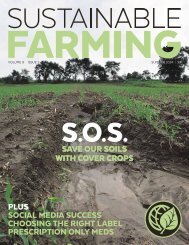
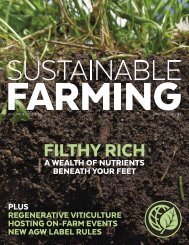
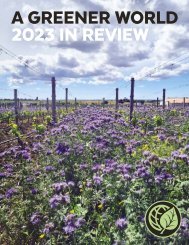
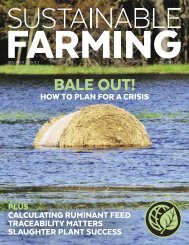

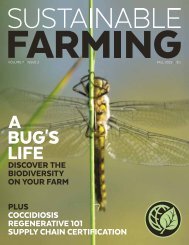
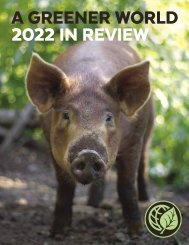
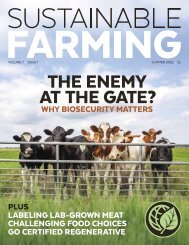
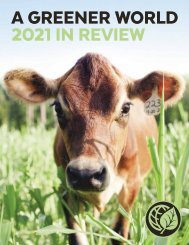
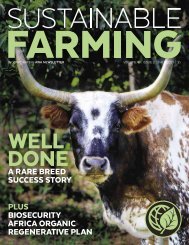



![SF Magazine V5 I1 -- Winter-Spring 2020 [SCREEN ONLY]](https://img.yumpu.com/63122871/1/190x245/sf-magazine-v5-i1-winter-spring-2020-screen-only.jpg?quality=85)